Christine Valters Paintner's Blog, page 119
March 8, 2016
Monk in the World guest post: Naomi Kelly
I am delighted to share another beautiful submission for the Monk in the World guest post series from the community. Read on for Naomi Kelly's reflection on lessons from a contemplative walk:
"Earlier this summer, my friend and I embarked on a series of contemplative walks in the Adirondack mountains of Upstate New York that she called “Yoga Hikes.” While scoping out some new trails, we visited a small creek near Whetstone Gulf State Park. At first, the creek’s wide banks were inviting us to walk along and enjoy the vegetation. There were – birds feet, timothy and clover, the types of grass used by farmers in the planting of their hay. Farther along there were all kinds of wild flowers, thriving even in early September, a time when most of the Adirondacks have already seen the first signs of Autumn. Among these, there were three kinds of wild asters, golden rod, and twisted stalk. It was like its own perfectly isolated Garden of Eden. The plants became fewer and fewer the longer we walked, replaced by strong lone plants, the seeds of which survived the spring flood by digging deep into the mud and finding enough nutrients to grow, flower, and to make more seeds. And it was good.
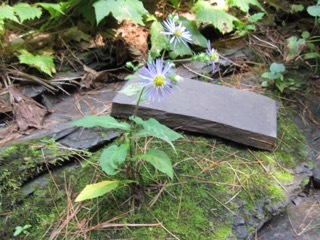 The rocks grew in size and splendor, manifesting all sorts of interesting colors and shapes. Some were smooth, having been rounded by the creek, some painted white with limestone, some jagged and sharp. Layers upon layers of shale looked as though they had been broken and shattered. Broken and shattered for you. And it was good.
The rocks grew in size and splendor, manifesting all sorts of interesting colors and shapes. Some were smooth, having been rounded by the creek, some painted white with limestone, some jagged and sharp. Layers upon layers of shale looked as though they had been broken and shattered. Broken and shattered for you. And it was good.
As we continued on our slow, mediative pace, the banks of the river became narrower, as the waters had cut deeply into the layers of sedimentary rock. In the same vein, the walls of rock become steeper, and with no bank to walk on we had to take off our shoes and walk in the creek. We felt the stones beneath our feet—the rounded and pointed ones we’d seen on the bank, but also stones slippery with algae and also minnows. Though we were lucky to spot a large snapping turtle basking on the rocks, none of us mistook his shell for a stepping stone. And that was very good.
The white bones of dead tree roots sat where they had been washed down in the spring. Bare but beautiful, their roots snaked around to create sculptures that would have been at home in any museum. The creek kept getting narrower with meanders and switch backs, deep and shallow pools. The banks became even steeper and higher, with a few pebbles falling here and there, disrupted from their high perch just by the wind’s smallest push. And it was very good.
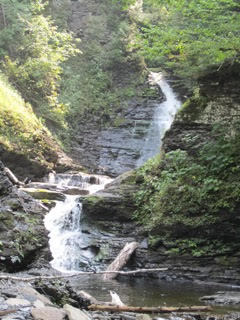 Each slow step, watching where our feet would touch, lifting and lowering, gently splashing, breathe in and breathe out. Was it around the next curve or the next? Expectation without anxiety, joy in each step, until around one more short curve in the high sided gorge, and we were there, standing before the falls, its sparkling water cascading down from a two-tiered rise, with the source of the falls not visible from where we stood. There was no way to climb up because the shale would have chipped away under your feet or cut them to bits. So we sat beside the pool and remained present, all quiet, all peace, a sacred place, a thin place, and we sat and breathed in the sparkling diamonds of air. And it was very, very good.
Each slow step, watching where our feet would touch, lifting and lowering, gently splashing, breathe in and breathe out. Was it around the next curve or the next? Expectation without anxiety, joy in each step, until around one more short curve in the high sided gorge, and we were there, standing before the falls, its sparkling water cascading down from a two-tiered rise, with the source of the falls not visible from where we stood. There was no way to climb up because the shale would have chipped away under your feet or cut them to bits. So we sat beside the pool and remained present, all quiet, all peace, a sacred place, a thin place, and we sat and breathed in the sparkling diamonds of air. And it was very, very good.
We watched the water dancing, swirling, falling. We ate rose mallow berries from the banks, ground cherries from our gardens, zucchini bread and oatmeal muffins. And it was deliciously good.
That’s when the sound of the jets started, the Air Force practicing maneuvers overhead, the loud and clear noise that funneled down into the gorge reminded us that we were not really in Eden, we were a part of a world who thinks that war solves problems, a part of a world where people die trying to leave their violence-torn homelands, a part of a world that thinks it can find the answer in their religious beliefs alone, a world where children die in violence, where disease and hunger rage. That can’t be good.
The sacred and the profane exist together in our world. If I let the sadness and fear in, the profane distracts me from remembering even to breathe. But as a monk in the world, I feel called to affirm the sacred, to make a difference for good, to breathe in the sacred and then exhale that healing and peace into a hurting world. And that is extremely good."
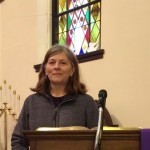 Naomi C. Kelly is a spiritual director and Presbyterian Pastor, and is embarking on a new retreat ministry called Weaving Home (www.weavinghome3.org) She lives in the Adirondack Park in upstate New York.
Naomi C. Kelly is a spiritual director and Presbyterian Pastor, and is embarking on a new retreat ministry called Weaving Home (www.weavinghome3.org) She lives in the Adirondack Park in upstate New York.
The post Monk in the World guest post: Naomi Kelly appeared first on Abbey of the Arts.
March 5, 2016
Embrace Attention and Presence for Lent ~ A love note from your online abbess
Dearest monks, artists, and pilgrims,
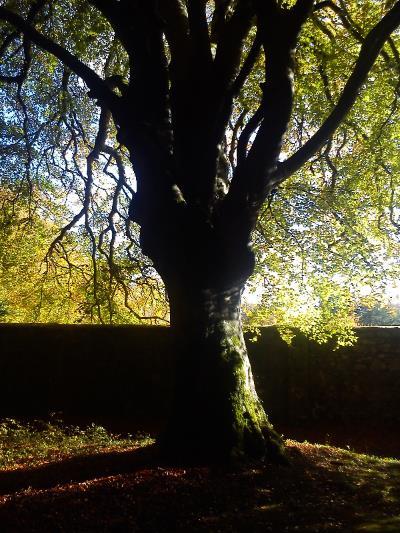 I continue my Lenten series at Patheos this week on A Different Kind of Fast. This week I explore fasting from multitasking and embracing attention to a single thing at a time.
I continue my Lenten series at Patheos this week on A Different Kind of Fast. This week I explore fasting from multitasking and embracing attention to a single thing at a time.
It can be so tempting to think, that in our busy lives multitasking will somehow make us more efficient and productive. We bemoan not having more hours in the day, but the hours we do have our attention is scattered, always trying to keep up. We spread our gaze between so many demands that we may get many things done, but none of it is nourishing.
St. Benedict wisely wrote 1500 years ago, that we are called to always be beginners in the spiritual life. The desert is a place of new beginnings; it is where Jesus began his ministry. In the desert, we are confronted with ourselves, naked and without defenses, called again and again to bring back all of our broken and denied parts into wholeness.
The monastic cell was a central concept in the spirituality of the desert mothers and fathers. The outer cell is really a metaphor for the inner cell, a symbol of the deep soul work we are called to, to become fully awake. It is the place where we come into full presence with ourselves and all of our inner voices, emotions, and challenges and are called to not abandon ourselves in the process through distraction or numbing. It is also the place where we encounter God deep in our own hearts.
Click here to continue reading the article>>
With great and growing love,
Christine
Christine Valters Paintner, PhD, REACE
Photo © Christine Valters Paintner
The post Embrace Attention and Presence for Lent ~ A love note from your online abbess appeared first on Abbey of the Arts.
March 3, 2016
Invitation to Lectio Divina: The Deer’s Cry
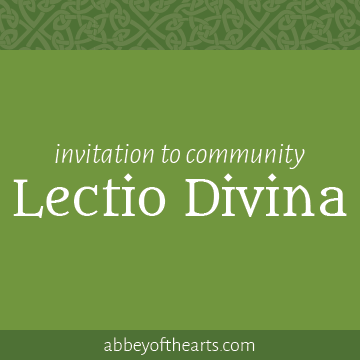 This month we celebrate the feast of St Patrick, one of Ireland’s patron saints, so we invite you into a lectio divina practice with the words from the first stanza of the song The Deer’s Cry: (you can click the link to see all of the lyrics, you are welcome to pray with the whole text if desired)
This month we celebrate the feast of St Patrick, one of Ireland’s patron saints, so we invite you into a lectio divina practice with the words from the first stanza of the song The Deer’s Cry: (you can click the link to see all of the lyrics, you are welcome to pray with the whole text if desired)
I arise today through the strength of heaven
Light of sun, radiance of moon
Splendor of fire, speed of lightning
Swiftness of wind, depth of the sea
Stability of earth, firmness of rock
How Community Lectio Divina works:
Each month there will be a passage selected from scripture, poetry, or other sacred texts (and occasionally visio and audio divina as well with art and music).
How amazing it would be to discern together the movements of the Spirit at work in the hearts of monks around the world.
I invite you to set aside some time this week to pray with the text below. Here is a handout with a brief overview (feel free to reproduce this handout and share with others as long as you leave in the attribution at the bottom – thank you!)
Lean into silence, pray the text, listen to what shimmers, allow the images and memories to unfold, tend to the invitation, and then sit in stillness. The text for prayer is above.
After you have prayed with the text (and feel free to pray with it more than once – St. Ignatius wrote about the deep value of repetition in prayer, especially when something feels particularly rich) spend some time journaling what insights arise for you.
How is this text calling to your dancing monk heart in this moment of your life?
What does this text have to offer to your discernment journey of listening moment by moment to the invitation from the Holy?
What wisdom emerged that may be just for you, but may also be for the wider community?
SHARING YOUR RESPONSES
Please share the fruits of your lectio divina practice in the comments below (at the bottom of the page) or at our Holy Disorder of Dancing Monks Facebook group which you can join here. There are over 4000 members and it is a wonderful place to find connection and community with others on this path.
You might share the word or phrase that shimmered, the invitation that arose from your prayer, or artwork you created in response. There is something powerful about naming your experience in community and then seeing what threads are woven between all of our responses.
*Note: If this is your first time posting, or includes a link, your comment will need to be moderated before it appears. This is to prevent spam and should be approved within 24 hours.
The post Invitation to Lectio Divina: The Deer’s Cry appeared first on Abbey of the Arts.
March 1, 2016
Monk in the World guest post: Barb Morris
I am delighted to share another beautiful submission for the Monk in the World guest post series from the community. Read on for Barb Morris' reflection on The Way of No Way:
"I hate not knowing — now knowing how to do something, not knowing where I am, not knowing what’s going to happen. Like many of us, I’m attached to competence and control.
My spiritual focus these days is being in “not-knowing” and being okay with that. I find this difficult. Is it easy for anyone?
 In the spring of 2014, my husband and I walked the Camino Francés, an ancient pilgrimage route from southern France to Santiago de Compostela in northeastern Spain, popularized in the 2011 movie “The Way.”
In the spring of 2014, my husband and I walked the Camino Francés, an ancient pilgrimage route from southern France to Santiago de Compostela in northeastern Spain, popularized in the 2011 movie “The Way.”
The Camino was physically difficult for me. Walking 500 miles in 37 days was hard on my feet and on my psyche. It required mental toughness, perseverance, and lots of forgiveness – of my husband, of my fellow pilgrims, and of myself.
The Camino is rigorous and demanding in many ways and fabulously simple in other ways. We had a defined end point, a clear route through often beautiful landscapes, and lots of help along the Way. Camino infrastructure is designed to support pilgrims – albergues, hostels, bars, cafes, ATMs, waymarkers, foot specialists, and helpful Spaniards abound. (The exception to this rule is the Spanish siesta, which means that churches, grocery stores, and pharmacies are shuttered from 2 to 5 pm, prime pilgrim visiting and shopping time.) All we had to do was get up, walk, go to bed, and then do it over again the next day.
The Camino was also deeply rewarding spiritually. Somehow, in ways I do not understand, because I was simply putting one often-hurting foot after the other for hours at a time, I got out of my own way. My mind quieted. I could hear my heart speak, and I could hear God speak, which is, I believe, the same voice. I didn’t have any visions. What I did have, though, were occasional moments of deep clarity, understanding, and connection. In one of these moments I knew that it was time to start consistently making art. In fact, that’s what I wrote down as my occupation at the pilgrim office in Santiago at the end of our journey. This was very surprising to me, as I’ve only ever dabbled as an artist. I have no formal art training whatsoever.
So, how do I follow my artist calling? I live in a culture that’s addicted to control, competence, and consumption. I resist change and I hate feeling incompetent. Yet here I am. This is where not-knowing comes in. To be true to my commitment to “a lifetime of ongoing conversion and transformation” (Monk Manifesto #7), I must submit to not knowing how to do this thing and to doing it anyway. I must allow myself to be at the mercy of God.
Here are a few practices I’m finding supportive as I learn to rest in not-knowing:
Being in my body. For me this means sweaty work, walking (and lately running), yoga, and body-focused meditations.
Spending time in nature.
Contemplative prayer, Lectio Divina, and meditation.
Eucharist.
Reframing my artistic endeavors as “messing around.”
Committing to one or several particular practices or disciplines, such as drawing or writing, for 30 days.
Sharing my journey, asking for help, and staying connected.
We can’t know what is going to happen. We’re not in charge of what’s going to happen. For me, faith right now this minute means choosing to walk in a world where God is in charge, and following this call to an unknown destination because I trust that the Caller will provide.
Rather than walking an ancient way to Santiago, trodden by millions for more than a millennium, I’m following The Way of No Way, knowing what I know and taking the next step in this holy roadless place where life and growth and transformation truly happen.
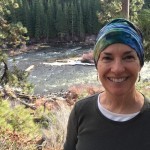 Barb Morris is a contemplative artist(!), writer, and life coach living in Bend, Oregon with her Episcopal priest husband. You can read more Camino reflections, see some of her art, and read her blog at www.barbmorris.com.
Barb Morris is a contemplative artist(!), writer, and life coach living in Bend, Oregon with her Episcopal priest husband. You can read more Camino reflections, see some of her art, and read her blog at www.barbmorris.com.
The post Monk in the World guest post: Barb Morris appeared first on Abbey of the Arts.
February 27, 2016
Embrace a Mindful Slowness ~ A love note from your online abbess
Dearest monks, artists, and pilgrims,
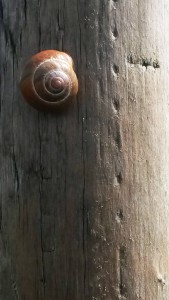 I continue my Lenten series at Patheos this week on A Different Kind of Fast. This week I explore fasting from speeding through life on the surface and embracing a mindful slowness:
I continue my Lenten series at Patheos this week on A Different Kind of Fast. This week I explore fasting from speeding through life on the surface and embracing a mindful slowness:
Modern life seems to move at full speed and many of us can hardly catch our breath between the demands of earning a living, nurturing family and friendships, and the hundreds of small daily details like paying our bills, cleaning, grocery shopping. More and more we feel stretched thin by commitments and lament our busyness, but without a clear sense of the alternative. There is no space left to consider other options and the idea of heading off on a retreat to ponder new possibilities may be beyond our reach.
But there are opportunities for breathing spaces within our days. The monastic tradition invites us into the practice of stopping one thing before beginning another. It is the acknowledgment that in the space of transition and threshold is a sacred dimension, a holy pause full of possibility. What might it be like to allow just a ten-minute window to sit in silence between appointments? Or after finishing a phone call or checking your email to take just five long, slow, deep breaths before pushing on to the next thing?
We often think of these in-between times as wasted moments and inconveniences, rather than opportunities to return again and again, to awaken to the gifts right here, not the ones we imagine waiting for us beyond the next door. But what if we built in these thresholds between our daily activities, just for a few minutes to intentionally savor silence and breath?
Click here to continue reading the article>>
With great and growing love,
Christine
Christine Valters Paintner, PhD, REACE
Photo © Christine Valters Paintner
The post Embrace a Mindful Slowness ~ A love note from your online abbess appeared first on Abbey of the Arts.
February 25, 2016
Invitation to Dance: Return to Me with Your Whole Heart
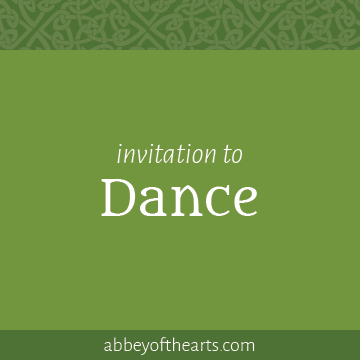 We continue our theme this month of "Return to Me with Your Whole Heart" which arose from our Community Lectio Divina practice with the Ash Wednesday passage from Joel and continued with this month's Photo Party and Poetry Party.
We continue our theme this month of "Return to Me with Your Whole Heart" which arose from our Community Lectio Divina practice with the Ash Wednesday passage from Joel and continued with this month's Photo Party and Poetry Party.
I invite you into a movement practice. Allow yourself just 5 minutes this day to pause and listen and savor what arises.
Begin with a full minute of slow and deep breathing. Let your breath bring your awareness down into your body. When thoughts come up, just let them go and return to your breath. Hold this image of "Return to Me with Your Whole Heart" as the gentlest of intentions, planting a seed as you prepare to step into the dance. What might this mean for you?
Play the piece of music below (“Pu Ert Solin” by Olafur Arnalds) and let your body move in response, without needing to guide the movements. Listen to how your body wants to move through space in response to your breath. Remember that this is a prayer, an act of deep listening. Pause at any time and rest in stillness again.
After the music has finished, sit for another minute in silence, connecting again to your breath. Just notice your energy and any images rising up.
Is there a word or image that could express what you encountered in this time? (You can share about your experience or even just a single word in the comments section below or join our Holy Disorder of Dancing Monks Facebook group and post there.)
If you have time, spend another five minutes journaling in a free-writing form, just to give some space for what you are discovering.
To extend this practice, sit longer in the silence before and after and feel free to play the song through a second time. Often repetition brings a new depth.
The post Invitation to Dance: Return to Me with Your Whole Heart appeared first on Abbey of the Arts.
February 23, 2016
Monk in the World guest post: George Angus
I am delighted to share another beautiful submission for the Monk in the World guest post series from the community. Read on for George Anugs' reflection the holy and creative process of working with a lathe:
"Although the following spiritual practice is written in the form of a recipe, it’s aim is not to be a how-to-guide. It merely demonstrates that in our spiritual nourishment, often overlooked ingredients can play a major role.
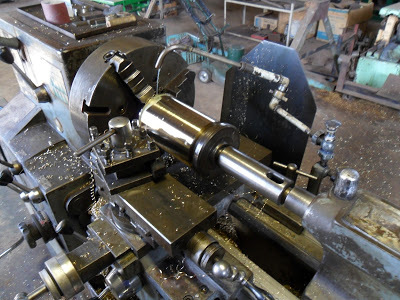 Ingredients:
Ingredients:
A workshop
A lathe (other machinery will do as well, but I find the rhythm and sound of the lathe to be soothing)
A turning job (not job as in “At least I have a job”. In the workshop we use it more in the sense of “Can you do this job for me, or do you have another one in the lathe?”). What works well is something repetitive, without being too complicated. Otherwise you have to concentrate too hard. A fairly big diameter or reasonable length is also an advantage. It ensures a nice long travel for the tool.
All the paraphernalia that goes with working on the lathe: enough soluble oil in the sump to keep the job lubricated, the necessary drills and tooltips, the wire hook that you use to remove the shavings from the bed, the splash plate to prevent the soluble oil from being flung in a fine spray all over the floor by the fast turning chuck, the peg spanner to fasten the chuck onto the head of the lathe and the chuck key to tighten the job in the jaws of the chuck.
Dogs. The amount does not matter. I usually have three with me in the workshop.
A notepad. Preferably nothing fancy. The complementary ones that you get from some of the steel and engineering suppliers are ideal. There is usually one in the workshop. Use a clean page so that you can tear it out if necessary. Do not write at the bottom of the rough sketch of the shaft and keyway that still has to be done or at the back of the drawing with the dimensions of the complicated crimping roller.
A sharp pencil. A pen is of no use in an environment where you constantly use oil or grease and your hands are always dirty. I love the soft dark writing of a 4B pencil. To me writing with an HB or harder is like kissing a rigid woman with a thin black line for lips. No joy there and afterwards almost no sign of the preceding contact.
Any flat surface. The welding table is perfect because the light is good on that spot and I pass it often on my way to the pedestal grinder. Just make a clearing for yourself amidst the welding rods, chipping hammer and G clamps.
Method:
With the job fastened in the chuck and everything set up, start the lathe.
I find a speed of about 280 rpm to be just right. Not too fast so that you have to be constantly alert and not so slow that you lose something of the rhythm. At 280 rpm the lathe gets a certain reassuring sweet sound that’s ideal for what we have in mind.
Get the feel of the job. See how the material reacts to the tool and determine the amount of soluble oil that is needed. It may be necessary to do some adjustment on the automatic feed of the tool.
Results won’t be immediate. It usually sets in at about the 12th or 15th repetition, but even that is not set in stone.
Be patient.
A certain unity comes over the workshop. Things merge and are somehow transformed into this single, huge, live organism with a body that gently rises and falls as it breathes – engaging the feed, taking the cut, disengaging, return to start, engaging the feed, taking the cut, disengaging, return to start… Rising and falling, breath in, breath out . . .
By this time the dogs are fast asleep all over the floor, their bodies mimicking the body movements of the big organism that is gently breathing around us and of which we are a part.
Wait. Do not force anything. Wait. Enter into the job, become one with it. Engaging the feed, take the cut, disengaging, back to start . . .
There . . . Do you see them coming? There is no predicting when or in what form it will emerge. It is not something that you create as such. It happens and is done unto you. Words and thoughts start to fill the air around the lathe. Solutions announce themselves, themes open up. Engaging the feed, taking the cut, disengaging, return to start . . .
Do not react too quickly. You have time. Delicately hold the fragile tension. At the end of the cut that you’re busy with, disengage the tool and switch off the machine.
Now take your pencil and gently gather the thought, image or words onto its tip.
Carry it to the note pad on the welding table.
Let it slide from the tip of the pencil onto the page. Write it down.
Repeat the process.
Through this method, many of the ideas and titles that now appear as posts on our blog came to me: Wabi-sabi, God in all things, Patron Saint SuBo, Whistle while you work . . . Others await their chance on the dirty page of my notepad to appear in print.
In many respects the turning and the writing become my spiritual practice.
I do not proclaim this process far and wide though. I don’t think many in the engineering business will believe me anyway if I were to tell them what a vital writing tool a lathe is. And in general I haven’t found in clergy, who are often strong on the word-side, a deep liturgical understanding of soluble oil or tool tips.
So I keep quiet and do my turning. Sometimes it is steel or wood. Often it is words. Always it is soul."
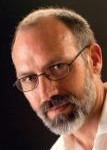 George Angus and his wife Matilda run a retreat centre in Northern Kwazulu Natal, South Africa. A restorer and maker at heart, he not only works with people, but also in wood and steel. He writes about finding God in all things on their blog The Restory News.
George Angus and his wife Matilda run a retreat centre in Northern Kwazulu Natal, South Africa. A restorer and maker at heart, he not only works with people, but also in wood and steel. He writes about finding God in all things on their blog The Restory News.
The post Monk in the World guest post: George Angus appeared first on Abbey of the Arts.
February 20, 2016
Fasting from Anxiety + Radical Hospitality ~ A love note from your online abbess
Dearest monks, artists, and pilgrims,
 I have two reflections and two poems for you this week. Read on for more goodness from the Abbey. . .
I have two reflections and two poems for you this week. Read on for more goodness from the Abbey. . .
I continue my Lenten series at Patheos this week on A Different Kind of Fast. This week I explore fasting from anxiety and entering into a radical stance of trust through the practice of Sabbath-keeping. Click here to read the article>>
I also have a guest post this week at the wonderful website Monasteries of the Heart on the practice of radical hospitality and inviting in holy disruption. Click here read the article>>
I am also delighted to have two poems published at the Galway Review website: “Holy Mountain” which is inspired by St. Patrick and “Last night I dreamt I was. . .” which is a love poem. You can read both poems here>>
With great and growing love,
Christine
Christine Valters Paintner, PhD, REACE
Photo © Christine Valters Paintner
The post Fasting from Anxiety + Radical Hospitality ~ A love note from your online abbess appeared first on Abbey of the Arts.
February 18, 2016
Invitation to Poetry: Return to Me with Your Whole Heart
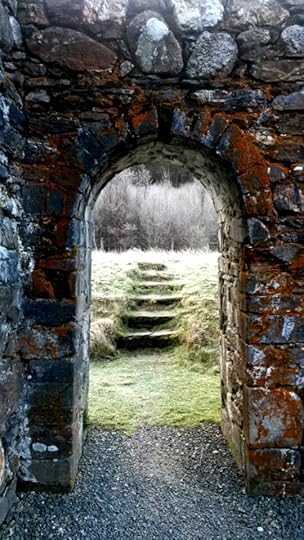
Welcome to our Poetry Party!
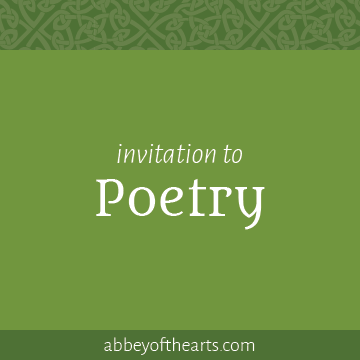 I select an image and suggest a theme/title and invite you to respond with your own poem. Scroll down and add it in the comments section below or join our Holy Disorder of Dancing Monks Facebook group and post there.
I select an image and suggest a theme/title and invite you to respond with your own poem. Scroll down and add it in the comments section below or join our Holy Disorder of Dancing Monks Facebook group and post there.
Feel free to take your poem in any direction and then post the image and invitation on your blog (if you have one), Facebook, or Twitter, and encourage others to come join the party! (If you repost the photo, please make sure to include the credit link and link back to this post inviting others to join us).
We began this month with a Community Lectio Divina practice with a passage from the Ash Wednesday reading from the Prophet Joel and followed up with our Photo Party. We continue this theme in our Poetry Party this month. What does the image above evoke for you? Express this through poetry.
You can post your poem either in the comment section below*or you can join our Holy Disorder of Dancing Monks Facebook group and post there.
*Note: If this is your first time posting, or includes a link, your comment will need to be moderated before it appears. This is to prevent spam and should be approved within 24 hours.
The post Invitation to Poetry: Return to Me with Your Whole Heart appeared first on Abbey of the Arts.
February 16, 2016
Monk in the World guest post: Meg Watson
I am delighted to share another beautiful submission for the Monk in the World guest post series from the community. Read on for Meg Watson's reflection initiation & ritual:
After 72 years of life, I am finally beginning to understand how important it is to have rites of initiation. I wrote before about two of the rituals I perform each day, i.e. making my bed and washing dishes. But as I was remembering a conversation I had with a friend today, I suddenly began to understand what rites of initiation are really about: they are meant to make life sacred.
I was thinking about how I was raised, not with rituals but with tasks, and how I resented the tasks. They were burdensome. I made my children feel the same way. There were beds to be made and rooms to be cleaned and other household chores to be done. Get that? Chores! How uninspired the word!
What if, as I heard a mother tell me long ago, some "chores" became rituals of accomplishment, recognition that the person had achieved the level of accountability and respect that meant they were allowed to perform some rituals on their own. For example, this mother told me that the first stage of initiation for a child entering school was to learn to pack his/her own lunch. This was a sign of a certain independence and maturity. For me, when I was growing up, my mother packed my lunch as well as my brother's and sister's. We would never have conceived it a part of our maturity to be allowed to pack our own lunches. My children were the same; naturally, I carried this same responsibility down from my mother. This was my job as a mom. What I didn't realize until most of the children had grown and I was working full time was that it should have been a badge of honor to be allowed to pack their own lunches. So when I didn't have the time to do it for them any more or they didn't care if I did or not, the job fell to them after all and they didn't really know how to do it, at least not well and not with any sense of accomplishment. It never had acquired the status of sacredness or privilege that it could have had.
So many other parts of life could be made sacred in the same way. Suppose I want my child to learn to make her bed and do it out of a sense of joy. I say to her, "Come, let's go make your bed together." Then she and I perform this ritual together, she learns the skill and we have the joy of sharing this time together. We make this a ritual that we do every day. Then one day I say to her, "Well, my dear one, I think you are big enough to make your bed all by yourself. Would you like that?" I leave her to do it and when she is finished she runs to me to show me what she has done. I look at it and marvel at her accomplishment, no judgment in me at all, simply the joy of what she has done. This becomes a ritual that is right for her age, one which has instilled within her the feeling first of having shared it with me, of doing it together, and then of doing it herself as an independent activity. It becomes a part of her day, one that flows naturally out of her own experience.
In this way I as a parent can begin to help my child find the joy of ritual in the mundane stuff of everyday life because that is where true joy lives. And in this way, we come to share the sacredness of daily life. Chores and tasks no longer exist. But before I can teach this to my child, I must own it for myself. I must reorient my being towards a vision of the sacredness of my own life. Surely I cannot teach my child what I do not recognize and practice myself.
So I must begin now to train myself to see each ritual that keeps me grounded in reality and that fills me with the joy of life. And that takes practice and thoughtfulness, or as the latest buzzword says, mindfulness. This means slowing down; if I intend to teach myself these rituals, I cannot rush through them helter-skelter. I must center my attention on them and cherish them, and that goes against everything our modern culture holds as valuable. So maybe I have to give up a lot of what modern culture values. Hmmmm . . . not a bad idea!
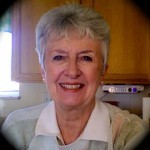 Meg Watson is retired, living in Colorado in domestic tranquility, with plenty of time for the contemplative life. She is a spiritual director and mentor who is delighted to share whatever truth comes her way and to listen to whatever truth others have found.
Meg Watson is retired, living in Colorado in domestic tranquility, with plenty of time for the contemplative life. She is a spiritual director and mentor who is delighted to share whatever truth comes her way and to listen to whatever truth others have found.
The post Monk in the World guest post: Meg Watson appeared first on Abbey of the Arts.



